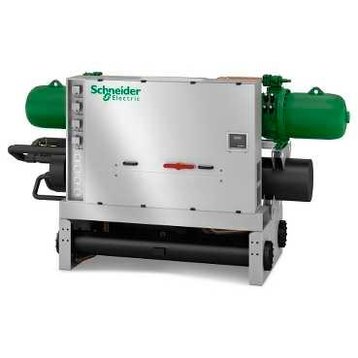Data center cooling systems follow the same thermodynamic principles that underpin the operation of household equipment ranging from small domestic fridge/freezers to industrial refrigeration installations. A refrigerant fluid is allowed to expand to a low-pressure low-temperature state before passing through the unit or area to be cooled, drawing heat away from it. It is then compressed to a high temperature and pressure and transmitted around a closed loop system to reject heat to the surroundings whereupon it is allowed to expand to a low temperature and pressure state before beginning the cycle again.
The heart of cooling
The compressor acts as the heart of a refrigerant-based mechanical cooling system, drawing the cool vaporised refrigerant that carries the heat away from evaporator coils, compressing it to a high temperature and pressure and pushing it around the refrigeration loop to effect heat rejection. There are many different configurations of compressor, each with their own trade-offs and areas of optimum application, to achieve this purpose.
For cooling air in the largest data centers the most appropriate choice of compressor is usually a centrifugal model, sometimes called a turbo or radial compressor.
Such models are most effective at power ratings above 700kW and can handle loads up to 10,000 tons, or a rating of 35MW, more than is possible with any other compressor technology deployed in data centers.
For loads up to 750 tons, or 2.6MW, an alternative technology called rotary-screw compression may be considered, but for the very highest-rated loads a centrifugal compressor is clearly the most appropriate option. Centrifugal compressors work on a principle that is different from all other compressors used in data centers large or small which are classified as positive-displacement models. In these, the gas is compressed in a chamber whose volume changes due to the operation of a piston, vane or rotary scroll or screw.
In a centrifugal compressor, cool vapour is compressed by adding kinetic energy via a rotating impeller. Cool vapour refrigerant is forced into and through the impeller which forces the fluid to spin faster and faster. The high-speed gas is then forced to pass through a diffuser where the refrigerant gas expands as its speed decreases. This process converts the kinetic energy of the high-speed low-pressure gas to a low-speed higher pressure gas. The higher the impeller speed, the higher the pressure.
The big benefits
A centrifugal compressor can be subclassified by the number of stages (single-stage, two-stage or multistage) and lubricating method (splash lubrication, forced lubrication or oil-free). In the case of oil-free lubrication the compressor uses friction-free magnetic bearings. As a result there are no mechanical wear surfaces which enhances efficiency and reliability, reduces noise and lowers maintenance costs.
Apart from their large capacity, centrifugal compressors offer other advantages compared with alternative technologies. They are more efficient under partial loads, which is typical of data-center applications. They also much more compact and have a much lower weight per unit capacity, offering as much as a 50 percent reduction in physical footprint and an 80-90 percent reduction in weight compared with the scaled-up models of rival compressors necessary to achieve equivalent cooling in large data centers.
Rival technologies cannot compete with centrifugal compressors at the highest power ratings but at the lower levels of the centrifugal compressors’ range of operation, 100 and 750 tons (or 350 to 2,600kW) the capital-cost advantages of rotary-screw or large piston compressors allow them to be considered as an option.
High-quality precision
Centrifugal compressors require higher-quality material and higher precision machining and manufacturing than other models which pushes up the initial cost of deployment. However this can be offset by their lower operation costs, and their better efficiency while operating at partial load. Furthermore, centrifugal compressors are impractical to design to a capacity below 20 tons, or 70kW power rating, because of the impeller’s high rotation speed and the difficulty of manufacturing an impeller at the small size that would be needed for smaller machines.
So with data centers, if you’re thinking big, you should be thinking of centrifugal-compressor based equipment at the heart of your cooling system.
For more information on this topic, please read white paper 254, The Different Types of Cooling Compressors
Victor Avelar is director and senior research analyst at Schneider Electric’s Data Center Science Centre



